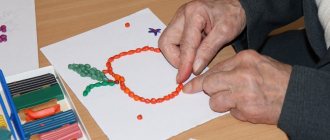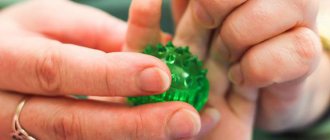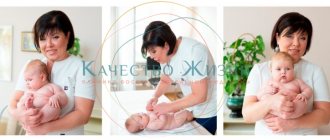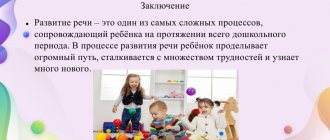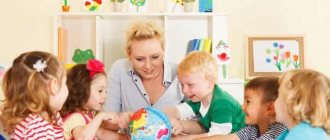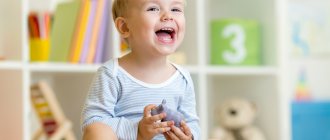A child’s speech development is a complex and lengthy process, which includes enriching vocabulary, understanding spoken words, and the ability to express one’s own thoughts, feelings, and desires. Each age has its own leading activity and its own norm of speech development. Speech development also includes the ability to compose sentences, phrases, and change words by cases and tenses.
What is normal speech development
Psychologists and speech therapists distinguish three main periods in the development of speech:
- Preparatory (from birth to 1 year).
- Pre-school (from one year to 3 years).
- Preschool (3 – 7 years old).
They are broken down into smaller stages. In each period, a child - with normal speech education and development - must master certain communication skills and learn specific things. For example, by the age of 3-4 years, a child’s vocabulary should already reach 3000-4000 words. The older the child, the more extensive and varied his lexical baggage should be, the easier it becomes for him to communicate with others. If some stage is missed, development is stopped (for example, by the age of three the child is still at the “booming” stage), then the norm has been violated, it is necessary to turn to specialists for help.
Parents need to know the norms of speech at a certain age and develop these skills, without overestimating them, but also not underestimating them. At first, you should not overload your child with learning poems and songs that are not appropriate for his age.
The importance of speech development in children at preschool age
The development of speech in children is perceived by many adults as the main indicator of intelligence. This approach is explained by the fact that awareness and logic can be traced in statements and conversation. Of course, thinking and speech as mental processes are closely interrelated. But speech development is only part of the intellectual level of an individual.
At the same time, for a preschooler speech is a multifunctional tool. With its help, he receives information and establishes contact with the outside world. Words help the child consolidate the result of objective activity in his mind. Thanks to speech, children come to perceive and use images.
The speech of a preschooler is egocentric and spontaneous. He speaks more to himself, using repetition and monologue. It's like thinking out loud, with the pronunciation of which comes understanding. Words serve as an activity enhancer and support the child in his actions.
For preschool children, the cognitive and communicative functions of speech are equally important. By listening to adults, they absorb information and discover the world around them. At the same time, children learn to speak and strive to be understood.
What influences the proper development of speech?
There are two groups of factors that influence speech development:
- Biological.
- Social.
The first include various pathogenic factors that can harm proper development: complex intrauterine development, brain infections and injuries, hearing impairment, heredity.
The second group is a combination of the child’s internal development processes and external conditions that are specific to each age stage. For example, the early separation of a baby from his mother sometimes causes emotional instability, impulsiveness, and behavioral disturbances. And this, in turn, leads to speech disorders.
Good conversation is influenced by examples and role models. The child first hears how they speak in the family, so he begins to try it himself. In order to correctly assimilate words during play activities, the child first accumulates impressions - this is the basis for future images and connections with them in speech. The development of gross motor skills also affects the correctness of conversation. The development of speech skills is influenced by the language a child learns to speak. An attempt to master several languages at once may slightly slow down a child’s development; his speech may develop more slowly.
In no case should a child be punished for mistakes in speech, teased or corrected with irritation. This can cause withdrawal and reluctance to try further.
The role of the family in the formation of speech reserve is key. Parents study poems and songs, recitations with their child, teach the child to speak at the right speed, and respond to his attempts to carry on a conversation.
Proper speech development is promoted by:
- Emotionally positive environment;
- Peace of mind in the family;
- Moderate sound communication between loved ones (no shouting);
- Feeling of security in the family;
- Patience of parents towards the child;
- Sensitive and friendly behavior of kindergarten teachers.
Parents' activity in the development of their child's speech
It is important for parents to consider that each child has his own individual pace of development. Noticing problems in the development of speech in their child in the preschool period and some discrepancy with the norms, they should not jealously compare with others and catch up with their peers, at all costs. However, this issue cannot be ignored.
Parental assistance is necessary for a preschooler in cognitive and speech development. Children, with the support of their parents, successfully progress in the following areas:
- vocabulary formation
- word creation
- development of verbal description skills.
In everyday communication with a child, parents have hundreds of opportunities to use new concepts and explain what they mean. Such simple participation of adults will significantly expand the active vocabulary of a preschooler.
Word creation allows the child to better understand the language and contributes to the development of a sense of rhythm. In addition to benefits in speech development, this activity brings incredible pleasure to children. Emotional speech, joint invention of new words with mom or dad is always accompanied by laughter and a joyful mood.
Parents can successfully teach verbal descriptions to their child. An adult can tell stories and describe what is happening to a preschooler, giving an example of a coherent statement, and then invite him to similarly describe what he sees around him. These activities are easy to do and can be done in any environment - at home or on a walk.
Main stages of speech development
Speech refers to the highest mental function. It depends on how developed the central nervous system is. It is both a means of communication and the basis of thinking. From the moment of birth, the baby finds himself in a social environment, which means he begins to listen and learn to communicate with the outside world. To be sure that development is going in the right direction, you need to know the norms and pathologies of speech for each age stage.
Speech of a child from 2 months to a year
This stage of development can be roughly divided into three stages.
- Booming. From 2 to 5 months. The child begins to intonate his cry, indicating his condition. Humming sounds appear, they are combined with vowels, they arise in communication with parents, and this is the child’s first conscious communication with adults (agu, agi, ge, aa, uh). At the same time, you can see the first smile, hear the child’s first laugh.
- Babble. This period lasts the longest - about seven months, up to one year. Syllables appear (la, yes, pa), word chains (pa-pa, la-la-la), and then the first words, for a start - consisting of identical syllables (pa-pa, ba-ba, ma-ma) . The speech apparatus is already configured to perform various movements, and unique sound combinations are heard (ma-ma-ma, la-la-pa).
- First words. By the first year of life, the child learns to pronounce his first words. Usually there are about 20-25. And they consist of the same syllables. During this period, the child begins to correlate what he says with specific actions, people, objects (the appearance of his mother - “ma-ma”, etc.). At this time, the baby is very actively engaged with toys, learns their names, is able to hear, perceive and find the desired object, not yet being able to name it independently (he will not say that it is a “cat”, but will find a cat among the toys).
Ideally, by the end of the first year of life, speech becomes the child’s main way of communicating with adults.
| Number of months from birth | Speech skills |
| 2 | Pronunciation of individual sounds, the appearance of the first spontaneous vocalizations, usually directed towards an adult. |
| 3 | Experimenting (stretching) with vowel sounds - “uh-uh”, “a-a-a”, “o-o-o”, humming, “cooing” (chest gurgling sounds). |
| 4 | The transformation of individual sounds into entire roulades and the flow of one sound into another - “o-o-o-o-o-o”. |
| 5 | The appearance of random babbling, rhythmic humming, the combination of vowels with some consonant sounds - “gu-gu-gu”, “bu-bu-bu”. |
| 6 | Improving random babble (“na-na-na”, “da-da-da”), merging vowel/consonant sounds, trying to imitate audible sounds, establishing a kind of dialogue with people around. |
| 7 | Frequent repetition of babbling, understanding the meaning of some words, the appearance of semantic pauses (the child babbled something and fell silent, waiting for an adult to answer). |
| 8 | Using babble as a way of communication, trying to pronounce different sounds and their echolalia (repetition without awareness of the meaning). |
| 9 | It is possible (but not necessary) that the first lightweight words “ba-ba”, “ma-ma” will appear, and babbling will become more complex. |
| 10 | Carefully listening to the speech of adults, expanding passive vocabulary, pronouncing new syllables and simple words (quite rare) - “av”, “na”. |
| 11 | An increase in the number of lightweight words or their appearance (if there were none before), semantic content of words and syllables (one word or syllable can have several completely different meanings). |
| 12 | Ability to understand more than 20 words, pronunciation of 5-10 simplified words, improvement of imitation. |
Didactic games in speech therapy for preschoolers
Norms of speech development from 1 year to 2 years
The next year of the baby’s life is a continuation of the previous stage. The first 12 months have prepared the articulatory apparatus, and the child is already actively using his own words. He knows how to imitate animals and everyday sounds around him. The following stages of development are distinguished:
- The child recognizes individual objects and understands questions regarding them: “where is the cube?”, “where is the girl?” etc. It can accompany its action with words and sounds. “Talks” with other children using sounds and imitation.
- The baby knows the names of objects and their qualities, emotional assessments. The first meaningful words: cat “meow-meow”, dog “aw-aw”, etc. Sounds may be skipped.
- Understands simple sentences that call for action: “Let’s go eat,” “Give me, please,” etc. Words generalize concepts, for example, “av-av” means all dogs at once, not a specific one. There are already about 30-40 words in the vocabulary.
- By the age of one and a half years, he pronounces almost all vowels and some consonants. Some of them soften. Sound substitutions occur (“ko” – milk). The dictionary has been expanded to 40-95 words. Speech is dominated by gestures, sounds, and facial expressions.
- Imitates adults as much as possible. He turns to them with requests: “Dad, give me!” Knows how to connect words into sentences: “Katya wants la-lya” (a doll). Speech becomes self-sufficient, gestures and facial expressions disappear.
- Knows how to replace incorrectly pronounced words with the correct ones: “la-la” - “doll”. By the age of one year and 9 months, he normally knows about 175 words, using 3-4 in sentences.
- Listens to fairy tales, poems and songs, distinguishes words by sounds (does not confuse mustache and ears). Indicates your actions during the game. Uses pronouns and adjectives.
- Recognizes words that relate to events in his own life. “We are going for a walk in the park, where we met a big dog.” Speech develops very actively when playing with dolls and animals. By the age of 2, the dictionary contains about 300-400 words. Most often - noun and verbs. Adverbs are added: here, here.
Norms of speech development for children aged 3 to 4 years
The writer Korney Chukovsky called this stage in a child’s life a period of “brilliant linguistic giftedness.” At this time, kids are engaged in a kind of creativity: they come up with their own words and names, entire structures, rhyme, compose, create concepts known only to themselves. What characterizes this age for speech:
- The vocabulary already contains 1500–2000 words. The norm is some distortion of difficult to pronounce words, rearrangement of syllables.
- Sentences are built from three to four words; at 4 years old he can pronounce common sentences.
- Complex and even complex constructions and homogeneous members are used.
- They actively use adjectives, pronouns, adverbs, and numerals.
- He can already pronounce vowels without making them soft. Phonetic errors are still the norm. For example, hissing ones are replaced by whistling ones.
- Difficulties arise with the letters “l” and “r”.
- The speech is generally not very coherent; there are some descriptive elements (“This is a cat. She drinks. She is soft.”).
- They easily remember and repeat poems, nursery rhymes, and songs by heart.
- An understanding of the rhythm and volume of speech comes. But kids are not yet able to regulate them on their own.
- They know how to reason and draw conclusions.
- State your first name, last name, patronymic, and the names of relatives and friends.
- Summarizes objects into groups, determines the signs of objects (hot tea, sweet honey) and actions (mom is sleeping, dad has come).
Norms of speech development from 4 to 5 years
At four years old, a child’s language is varied and precise, emotionally vivid. He asks questions and is happy to read and listen. And:
- The vocabulary consists of 2500-3000 words.
- Accurately names objects and their qualities.
- He comes up with his own words and even poems.
- There are many adjectives and prepositions in speech.
- There are more personal pronouns
- A child can form a logically correct statement from several sentences.
- Monologue speech and retelling are mastered.
- Able to clearly and colorfully describe an object, picture, or toy.
- Almost all sounds are pronounced correctly (there may be exceptions with “L” and “R”; they take the longest to form).
- Able to reduce sound volume and speak in a whisper.
- He doesn't speak quickly.
- Uses expressive intonation to read poetry.
Norms of speech development for children 5 – 7 years old
By the age of six, a child can already speak freely with peers and adults. Ideally, by the age of seven, he is ready to master the school curriculum and does not experience communication difficulties. What characterizes this period:
- Many collective nouns and adjectives appear, denoting states and abstract concepts.
- Knows how to use general concepts (“Transport” is an airplane, a bus, and a car).
- Knows and distinguishes between seasons, plants, animals, berries, mushrooms, birds, fish, etc.
- Knows where right is left; how much time.
- Uses the names of days of the week, days, months.
- Knows the name of the country and capital.
- Operates with geographical concepts.
- Knows the rules of pedestrian traffic.
- Declines nouns according to numbers and cases.
- Able to agree nouns with numerals, and adjectives with nouns.
- Uses all parts of speech correctly
- Speech is coherent, able to retell a fairy tale or story.
By the age of seven, there are almost no errors in speech, all sounds are clear, the accents are correct.
| Child's age in months/years | Speech skills |
| 18/1,5 | The presence in the active vocabulary of 5-20 words, mainly nouns. Frequent repetition of one phrase or word, willing repetition of emotionally charged jargon (“eat”, “kitsia”, “musenka”, etc.), the ability to fulfill simple requests. |
| 24/2 | The ability to name different objects from one’s environment, the use of several prepositions, sometimes not entirely correctly (on, under, in). Composing short sentences - “let me drink”, “look, kitsya”, having in the active vocabulary from 100 to 300 words. Occasionally correct use of the pronouns “I”, “you”, “me”. The question “what is this?” appears. |
| 36/3 | Correct use of pronouns, occasional use of some nouns in the plural and verbs in the past tense. Correct use of at least three prepositions – for, on, under; ability to correctly name and show body parts. The active vocabulary ranges from 900 to 1000 words, and the child’s speech is 90% understandable to others. Understanding complex questions (“Are you hungry now?”) and the ability to give an adequate answer to them. |
| 48/4 | Correct use of at least 4 prepositions. Understand and reproduce the names of familiar animals and various objects in magazines or books. Correct repetition of words with four syllables, understanding the ratio of big/small, many/little. Easy fulfillment of simple requests, frequent repetition of various syllables, sounds, phrases and words. |
| 60/5 | Use of many descriptive words – adverbs and adjectives; speech is 100% understandable to adults, despite the possible presence of some articulation problems. Repeating sentences up to nine words; the ability to name household items and understand what they are needed for. Distinguishing between the concepts of today/yesterday/tomorrow; fulfilling three consecutive requests; reducing the number of grammatical errors in speech. |
| 72/6 | The ability to roughly navigate time, compose a coherent story from a picture. The presence of more than 2000 words in the active vocabulary; the emergence of questions “why?”, “why?”, rapid enrichment of vocabulary. |
| 84/7 | Mastery of coherent speech, the ability to retell a text heard or read. There may be small errors when pronouncing complex sentences with participial phrases. Modulation of intonation and volume of the voice, correct articulation of all sounds. Replenishment of active vocabulary up to 3500 words, improvement of speech attention and intensive development of logical thinking. |
Exercises for a 2-3 year old child to develop speech
Phonetic age-related features of children's speech
Preschool age is the most favorable for the formation of the correct pronunciation of all sounds of the native language. (5)
The speech of a small child is formed in communication with the adults around him. In the process of communication, his cognitive and objective activity is manifested. Mastering speech rebuilds the baby’s entire psyche, allowing him to perceive phenomena more consciously and voluntarily. The great Russian teacher K.D. Ushinsky said that the native word is the basis of all mental development and the treasury of all knowledge. Therefore, it is so important to take care of the timely development of children’s speech and pay attention to its purity and correctness.
The richer and more correct a child’s speech, the easier it is for him to express his thoughts, the wider his opportunities for understanding reality, the more meaningful and fulfilling his relationships with children and adults, the more active his mental development occurs. Any speech disorder to one degree or another can affect the child’s activities and behavior. Children who speak poorly, beginning to realize their shortcomings, become silent, shy, and indecisive. The correct, clear pronunciation of sounds and words by a child during the period of learning to read and write is especially important, since written speech is formed on the basis of oral speech, and speech deficiencies can lead to academic failure. (8)
Theoretical foundations of the problem of preschoolers mastering correct sound pronunciation.
Scientific foundations of sound pronunciation techniques
The Russian language has a complex sound system, which is why many researchers who study the theory of sounding speech pay attention to it. It is on the basis of an analysis of the sound structure of a language that a basis is created for a theoretical understanding of the processes occurring in the language. Scientists characterize the sound units of language in terms of sound formation (these are the articulatory properties of the language), sound (acoustic properties) and perception (perceptual qualities). All these units are interconnected.
A.N. Gvozdev showed how much work a child does in mastering the phonological means of language. It takes a child different amounts of time to master individual speech sounds. The correct conditions for raising and educating a child lead to the mastery of the grammatical and sound aspects of a word.
Research by linguists, psychologists, and teachers gives reason to believe that it is the sound side of language that early becomes the subject of a child’s attention (L.S. Vygotsky, D.B. Elkonin, N.H. Shvachkin, F.A. Sokhin, M.I. Popova , A.A. Leontyev, A.M.Shakhnarovich, E.I. Negnevitskaya, L.E. Zhurova, G.A. Tumakova).
Speaking about the child’s acquisition of the sign side of language, L.S. Vygotsky emphasized that first the child masters the external structure of the sign, i.e. sound. D.B. Elkonin wrote: “It is obvious that the development of coherent speech in a child and the closely related acquisition of grammatical structure are impossible without mastering the sound system of the language.” The latter, according to Elkonin, represents the basis for the development of a child’s speech. “Mastering the sound side of a language includes two interrelated processes: the formation in a child of the perception of the sounds of the language, or, as it is called, phonemic hearing, and the formation of the pronunciation of speech sounds.”
Psychologists associate the number of correctly pronounced sounds with the expansion of the stock of actively used words. The method of teaching preschoolers to read, developed by Elkonin and his followers, is based on working with the sound side of language.
Phonetic observations of children's articulation create the basis not only for the formation of speech hearing, but also for the development of a culture of oral speech in its pronunciation aspect. L.V. Shcherba emphasized that studying the grammar of a living, spoken language accustoms the student to observing his own language: understanding the meaning of a word, he connects it with the sounds that make up this word. This is where observations begin on the pronunciation of a word, the phenomenon of alternation of vowels and consonants. (7)
Sound pronunciation is the process of formation of speech sounds, carried out by the respiratory, voice-producing and sound-producing sections of the speech apparatus with the regulation of this process by the central nervous system. (6)
Phonetic age-related features of children's speech
The acquisition of correct sound pronunciation occurs over a fairly long period of time (from 3 to 5 years), and not for all children at the same time. Some children begin to pronounce all sounds correctly early (by 3-4 years), others learn them a little later (by 5-6 years). Some sounds require simple articulation, while others require more complex articulation. Therefore, the baby first learns those sounds that are easy to pronounce, and sounds that are more complex in terms of articulation appear later.
1 year of life:
In the first year of life, the child’s brain and speech organs intensively develop. The brain is the main regulator of the body's activity. In a newborn, it is still underdeveloped, has less mass, and a less complex structure. Starting from the first year of life, a child’s brain develops rapidly and its internal structure changes. Simultaneously with the development of the baby’s brain, physical and phonemic hearing is formed. Hearing plays a leading role in mastering speech. If a child cannot hear, then speech cannot develop without special training. Hearing the speech of others, the baby begins to first listen to the sounds, look for the source of the sound, and then turn his head towards the speaker, focusing his attention on his face and lips, thus trying to establish contact with the adult.
Simultaneously with the development of hearing, the baby exhibits vocal reactions; he pronounces a variety of sounds, syllables, and various sound combinations. At 2-3 months, humming appears, and at 3-4 months, babbling appears.
In the first months, the baby pronounces sounds involuntarily. These sounds are unclear, sometimes they are not even present in the child’s native language, and some of them cannot be reproduced at all. Children of different nationalities during this period pronounce the same sounds, regardless of what language they subsequently learn. However, then the baby begins to pronounce only those sounds of his native language spoken by the people around him.
Starting from the second half of the year, clear sounds appear in the baby's babble. Among them, the most common are the vowel sound [a], consonant sounds [p], [b], [m], [k], [t] and some others. However, these sounds are not yet stable enough and are pronounced only in small sound combinations. At the early stages of speech development, a child, playing with sounds, exercises his speech apparatus and hearing, thus preparing them for the correct assimilation of sounds in the future.
By the end of the year, the child pronounces mainly articulatory sounds: vowels [a], [u], [i], some consonants: [m], [p], [b], [n], [t], [ d], [k], [g]. Moreover, some children pronounce a greater number of sounds and more clearly, others - fewer and less clearly. The quality of pronunciation depends on the condition and mobility of the organs of the articulatory apparatus, which is just beginning to actively function, so the role of babbling is of great importance for its further development.
2nd year of life:
In the second year of life, children quite clearly begin to pronounce such vowel sounds as [a], [u], [i], [o], but the sounds [s], [e] are replaced with the sounds [i], [ye]; Most children either do not pronounce most consonants at all, or pronounce them incorrectly, replacing them with sounds that are simpler in terms of articulation. They replace a number of hard consonants with soft ones. This mainly applies to the front-lingual sounds [g], [d], [s], [z] (dyai instead of dai, syanki instead of sanka). There are also no hissing sounds, sounds [l], [r'], [r], which indicates that the child’s articulatory apparatus is not yet sufficiently strong.
Along with incorrect pronunciation of sounds, there is a simplified pronunciation of words when they are shortened or only one syllable is pronounced, most often the stressed or first one (ko or moko instead of milk).
Often a child pronounces the same word in different ways, and one can observe the loss or replacement of one or another sound.(4)
3rd year of life:
By the age of three, children generally master sound pronunciation. However, their speech is still imperfect phonetically. It is characterized by a general softness (“zyuk” - beetle, “syuba” - fur coat, “net” - no, etc.); replacement of the back-lingual sounds k, g with the front-lingual sounds - t, d (“tutolka” instead of doll, “dusi” instead of goose), sometimes replacing voiced sounds with unvoiced ones. A significant proportion of three-year-old children do not know how to pronounce hissing sounds, most often replacing them with whistling sounds (“sapka”, “koska”, “zuk”). There is an inability to pronounce the sound r (omitting or replacing it), distortion of the sound l.
4th year of life:
By the beginning of the fourth year of life, a child, under favorable upbringing conditions, masters the sound system of the language. A significant proportion of children master many sounds; word pronunciation improves; The child’s speech becomes understandable to others. At the same time, there are still a number of imperfections in children’s speech. Individual differences are observed in children's speech disorders.
Note that in practice there is a widespread opinion that by the age of four, children’s pronunciation corresponds to age characteristics and program requirements; no major deviations from the norm are observed. Imperfections in the pronunciation of children of primary preschool age are usually considered as an age-related pattern that goes away on its own. Hence the underestimation of the need for training in the formation of the sound side of speech at this stage.
Mastering correct pronunciation in early preschool age is hampered by insufficient development of motor skills of the speech apparatus and phonemic hearing, and insufficient stability of neural connections. Children do not yet have a conscious attitude towards the imperfections of their pronunciation.
The characteristics of age also determine the content of training: overcoming the general softness of pronunciation; education of correct articulation and clear pronunciation of vowel sounds: a, u, i, o, e; clarification and consolidation of the pronunciation of consonant sounds p, b, m, t, d, n, k, g, f, v; whistling sounds - s, z, c; development in children of speech breathing, auditory attention and phonemic hearing, motor skills of the speech apparatus; preparation of the articulatory apparatus for the pronunciation of hissing and sonorant (l, r) sounds.
5th year of life:
Children of middle preschool age master the pronunciation of all sounds of their native language, including sounds that are difficult to articulate. The process of mastering sounds is complex; it is characterized by instability of pronunciation, when a child pronounces sounds correctly in one sound combination, but incorrectly in another.
Some children have imperfect pronunciation of whistling, hissing and sonorant (r, l) sounds due to insufficient development of speech motor mechanisms.
In the development of the sound side of speech in children in the fifth year, a kind of inconsistency is observed. On the one hand, special sensitivity, special susceptibility to speech sounds, sufficiently developed phonemic hearing; on the other hand, insufficient development of the articulatory apparatus and complete indifference to articulation.
The content of the training is to consolidate the pronunciation of vowels and consonants, practice the pronunciation of whistling, hissing and sonorant (r, l) sounds.
6th year of life:
By older preschool age, children develop the ability to self-control, awareness of the imperfections of their speech and, accordingly, the need to acquire knowledge and the need for training. Therefore, educational activities become more serious. Children show cases of mutual assistance - attention to each other's speech, a desire to help comrades.
By the senior preschool age, with the correct setting of work, children master the pronunciation of all sounds of their native language. Their speech hearing, articulatory apparatus and speech breathing are sufficiently developed. Phonemic perception and the ability to sound speech analysis develop.
The child begins to be critical of his pronunciation, realizes his defects, is embarrassed by them, and sometimes refuses to answer.
Due to pronunciation problems, children replace words with a defective sound in their speech with those where it is absent (not “cucumber”, but cucumber). For the same reason, they may perform the task incorrectly, replacing the necessary words with others that are similar in meaning to the first ones (instead of horse - horse, instead of bear - bear, instead of car - truck).
In the sixth year, they improve the articulation of sounds, the differentiation of mixed sounds, and continue to develop speech perception.
7th year of life:
In the seventh year, the primary development of phonemic perception and sound analysis of speech occurs. (1)
Speech therapy classes for speech development
Independent activities with your child to develop and strengthen communication skills can be done at home.
- Fine motor games (finger)
- Articulation gymnastics
- We develop hearing, onomatopoeia and logorhythmics (poems with various movements).
- Games for hearing development, games for sound imitations and logorhythmics (poems with movements).
- We learn and read poems to expand our vocabulary.
- Speech imitation. Show a model of behavior (birds, mothers, cats) and ask the child to reproduce with the necessary sounds (the cat purrs “purrr...”)
- Poems with action. Tell a poem, illustrating it.
- Reading.
- Development of fine motor skills. For example, decorate clothes with clothespins and ask the child to take them off.
- Mandatory sensory development (use taste, touch, smell in games).
- Guess which object is ringing; guess where the sound is coming from; imitate everyday sounds.
Muscle strengthening exercises
- "Smile". Stretch your lips in a smile, hiding your teeth. Hold for up to 30 seconds.
- "Fence". Smile so that all your teeth are visible. Hold the smile.
- “Punish the tongue.” Open your mouth a little, put your tongue on your lower lip, slap it with the sound “five-five-five.”
Parents' mistakes
Often it is the inattention of parents that leads to disturbances in the child’s speech. The main mistakes that are made in the family:
- Lack of help for the baby. Parents do not pay attention to communication.
- Adults “lisp”, distorting speech, giving the child the wrong role models.
The child remembers that his parents like his soft, childish pronunciation and is in no hurry to get rid of it, thus receiving love.
- Ignoring developmental delays.
- Reluctance to correct speech (including your own, for example, pronunciation defects, haste).
- Poor speech experience in a child. The baby is simply not taught to talk, and it is difficult for him to communicate, he does not know how to do this.
- Parents are tired and not ready to talk; it is easier for them to provide their child with a computer or phone with games.
- Adults read little to children.
When to see a speech therapist
There are several conditions under which you need to seek help from a specialist.
- There is no humming or babbling.
- By two years, the vocabulary is completely undeveloped or the child does not speak at all.
- Does not pronounce simple sounds or replaces them (“k” with “t”, etc.).
- If by the age of three the baby speaks a language that only he understands.
- The child understands everything, reacts to everything, but does not speak.
- If at 4-5 years old speech is slurred, many sounds are not pronounced.
- If after the age of five the child continues to speak softly (“kisya”).
- By the age of six, individual sounds are not pronounced correctly.
- Speaks with hesitation, repeats syllables, stutters.
- A child over 6 years old cannot learn a poem or retell what he heard.
The way a child talks speaks volumes about his mental health. And if there are any hints of deviations from the norm, it is best to contact a specialist. He will tell you whether it is possible to straighten your speech at home or whether you need classes with a doctor. If correct speech is not formed by the age of seven, problems with learning and communication may arise, which will reduce the child’s quality of life in the future.
